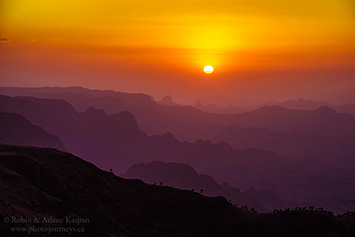
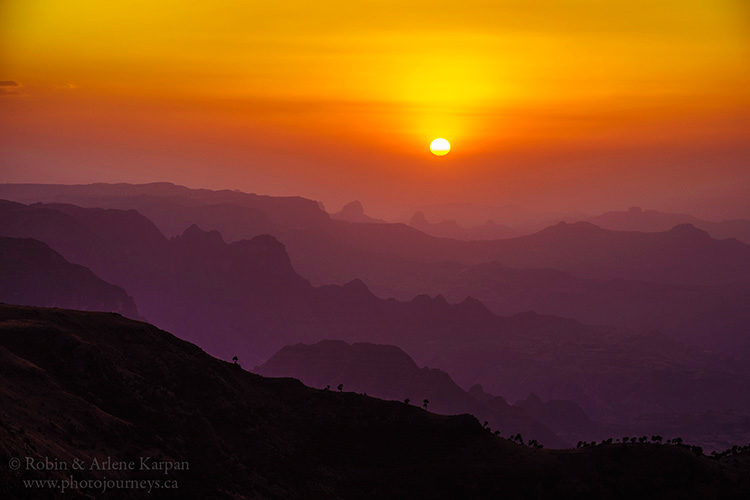
Our hearts pound and lungs gasp for air with each upward step. The air thins as our path tops altitudes over 4,000 metres, but jaw-dropping views more than make up for any discomfort. Standing on the edge of the escarpment, we gaze over soaring jagged peaks, stone columns, and gorges dropping into oblivion.
We’re on a five-day hiking and camping trip through the Simien Mountains of northern Ethiopia, part of a vast mountain plateau dubbed the Roof of Africa. It was named a UNESCO World Heritage Site for the combination of dramatic scenery and rare species, some of which occur nowhere else on Earth. Indeed, it was among the first places in the world chosen when the UN first started designating sites of outstanding cultural or natural significance.

We’ve never taken a hike quite like this. We not only had our guide, Getachew, but also cook Estefen and his assistant Melaku, plus mules with handlers who hauled everything between campsites. Then there was Jemale, the national park scout who was never without his Kalashnikov rifle. Park regulations require all hiking parties to have an armed scout “for protection”. While bandits in the hills were a concern a few years ago, these days it’s more to provide employment in this impoverished region.
Simien Bound
We begin our journey with a one-hour flight from the capital of Addis Ababa to the northern city of Gonder, then a three-hour trip by van to Debark, home to the national park headquarters. Motorized traffic on the highway is fairly light, though there’s no shortage of donkey carts, herds of sheep and goats, horses, mules, and people walking. Passing through villages, we have to negotiate the tangle of humanity and livestock spilling onto the road.
The van driver leans on the horn and the mass slowly parts enough to make it through. We hit a traffic jam behind a slow-moving donkey cart, its driver wrapped in a blanket. The rickety cart is loaded with firewood, its crude wooden wheels wobbling as if ready to fall off. The scene seems right out of Biblical times, except that the driver is talking on his cell phone.

Leaving Debark, our van winds up a dusty, bone-jarring road. Higher and higher we climb into the mountains, enter the national park gates, and before long are dropped off with Getachew and Jemale for a four-hour hike to the first campsite. The relatively short walk helps us acclimatize to high altitudes, with little elevation gain along the edge of the escarpment. Since we are already at over 3,200 metres, we are treated to stunning views right from the start. Remnants of ancient volcanoes and 40 million years of erosion have formed a sea of barbed peaks and pinnacle rocks, broken by gorges and chasms. Some cliff faces drop over a kilometre, almost straight down.
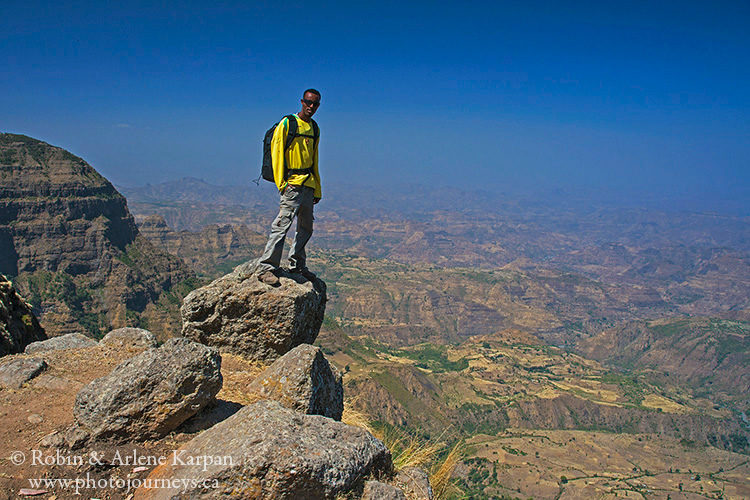
The mountains are known for their high biodiversity, including several endemic plants and animals. Most impressive are giant lobelias, short palm trees with long flower stems that shoot straight up as much as 10 metres.
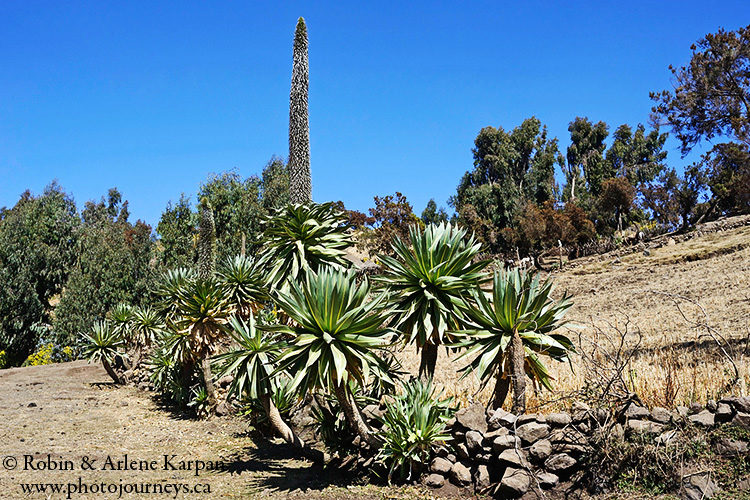
In late afternoon we arrive at Sankaber campsite, nestled in a clump of trees near a spectacular cliff-top viewpoint. The only buildings are simple round shelters used for cooking, and a couple of even simpler toilets – essentially concrete structures with holes in the ground. Our tent is already set up, with a folding table and chairs nearby. Estefen and Melaku welcome us with tea and popcorn. We could get used to this. It’s a far cry from our usual hiking trips where, after walking all day, we still have to set up camp then think about cooking.
Fine Dining in the Clouds
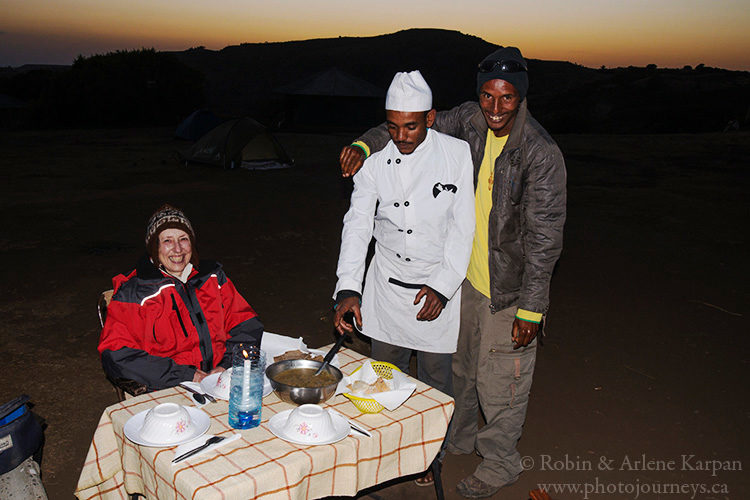
Just as the sun sets, Estefen brings our supper. He’s dressed in his chef’s hat and white jacket, an incongruous sight in this wilderness setting, but a nice touch. A candle stuck inside a cut-off plastic water bottle provides light and adds a splash of elegance to our first meal in the mountains.
We’re suitably attired for dining, wearing every piece of clothing we have with us. It may be shirt-sleeve weather as we hike during the day, but as soon as the sun goes down, the temperature drops like a rock. We quickly don sweaters, warm coats, tuques, and gloves. At night we sleep in wool long johns inside down sleeping bags. When we wake next morning, our thermometer shows about 0 degrees Celsius.

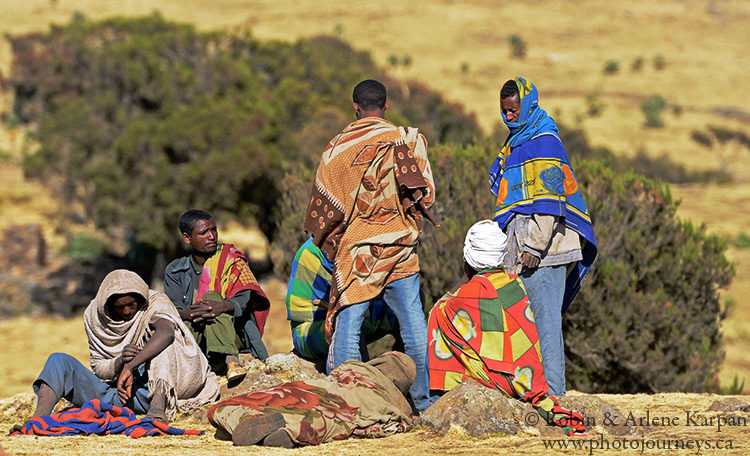
Most tents in the campsite are for trekking guests. Some guides or other helpers have tents, but most simply make do. Cooks sleep in the cooking shelter. Scouts and mule handlers normally stay outside, wrapped head to toe in their ubiquitous blankets that often double as coats.
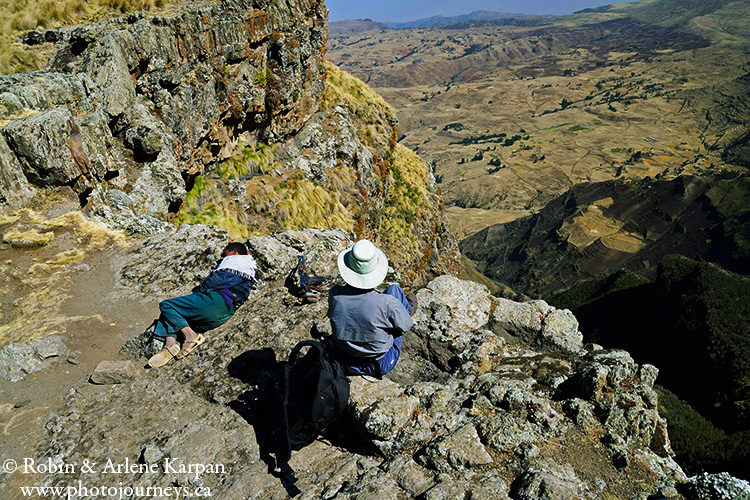
The terrain gets progressively rougher past Sankaber. A ridge takes us to a lookout point, next to the appropriately named Geech Abyss, where the land drops into nothingness. We watch lammergeyers, or bearded vultures, soaring effortlessly on the thermals, some flying far below us in the deep chasms. Across the narrow gorge we look over a waterfall, now a mere trickle in the bone dry conditions, with a single 500-metre drop straight down.
We enjoy the view until Getachew breaks the news that we have to cross that gorge. The path takes us downhill for a while, but then we climb back up even higher. As it turns out, the downhill stretches prove to be every bit as challenging. There’s less huffing and puffing than going up, but more strain on our knees. We constantly rely on our walking sticks to keep from slipping down the loose, dusty soil.
Life in the Park
Despite this being a national park, villages dot the landscape, and we see people herding sheep, goats, and cattle. All around us we see cultivated crop land covering slopes that would make a mountain goat dizzy. We pass beside a man breaking a new plot of land, a formidable task using an ox pulling a primitive wooden plow through ground that seems more rock than soil. More natural habitat is destroyed, but his family has to eat.
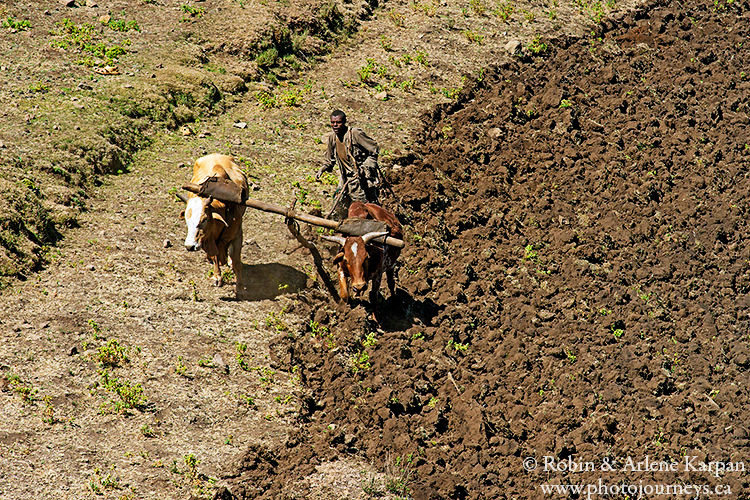
Human activities have been serious enough that UNESCO temporarily placed Simien National Park on its List of World Heritage in Danger. Fortunately, recent conservation measures have improved enough for the park to be taken off the danger list.
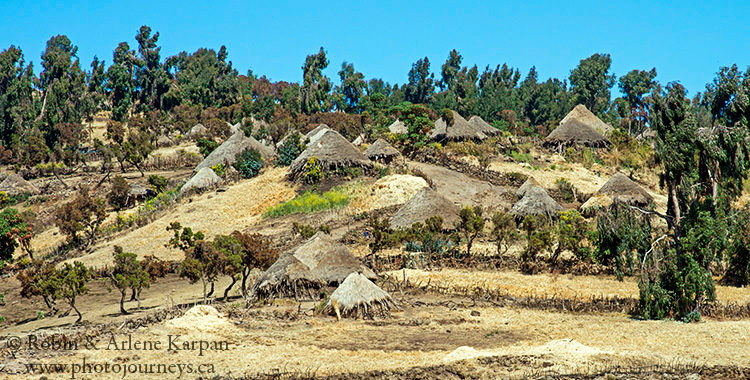
Our approach to Geech village seems surreal. The settlement sprawls across the hillside – an assortment of round buildings of rocks and mud, topped with substantial thatched roofs. In most remote rural villages in Africa, we usually see corrugated tin or other trappings, however modest, from the modern world. Looking at Geech from across the valley, there is absolutely nothing to remind us that we are still in the present, that we haven’t somehow been transported a thousand years back in time.

The campground just past Geech sits on an exposed windswept plateau. We arrive completely exhausted. After an hour or so of rest (accompanied, of course, by the customary hot tea and popcorn), Getachew tells us that this is the best place to see sunset. There’s just one glitch – the viewpoint is a bit of a walk away, uphill of course. We trudge up the long slope to the edge of a precipice plunging into dark shadows. While the setting would be spectacular any time, the lingering evening light casts a magical glow across the slopes and peaks. Haze covers the horizon, diffusing streaks of warm light over the wild land.
Gentle Geladas
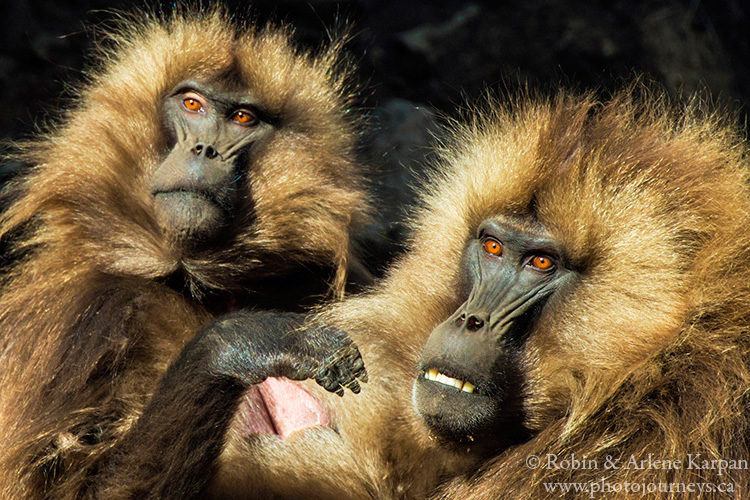
Next day we have our first close encounter with gelada baboons. Found only in the highlands of Ethiopia, geladas are the world’s highest dwelling primates, other than humans. Unlike most other baboons and monkeys, they only rarely venture into trees. As grass-eaters, geladas prefer to walk and shuffle along the ground where they pick blades of grass with their hands. They live in larger groups than other baboons and often “talk” to each other using a varied repertoire of high-pitched calls. Sounds made by baby geladas are remarkably like cries of human babies.
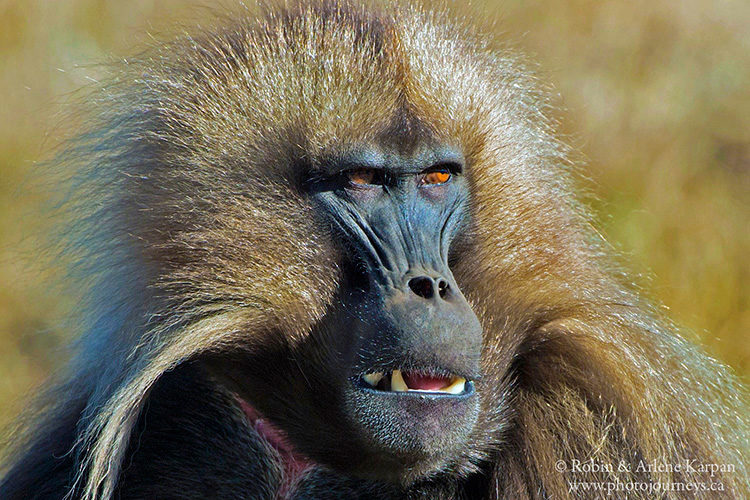
Our immediate impression is how gentle and easy-going they appear. If we stand in one spot in the general direction they are heading, they will walk right beside us and barely give us more than a bemused look. Big males have hair to spare – luxuriant, golden, and shaggy, lion-like manes. Occasionally they open their mouths wide and roll back their lips to display sharp teeth – a threatening gesture to male competitors.
At the next summit we stop for a rest and can see our final destination, Chenek campground, looming far below. This is the steepest descent of all, along a series of eroded switchbacks and goat trails. In the valley we see a few thatched-roofed buildings in a village, cultivated land reaching way up the opposite slope, and the road where a distant truck looks like a miniature toy.
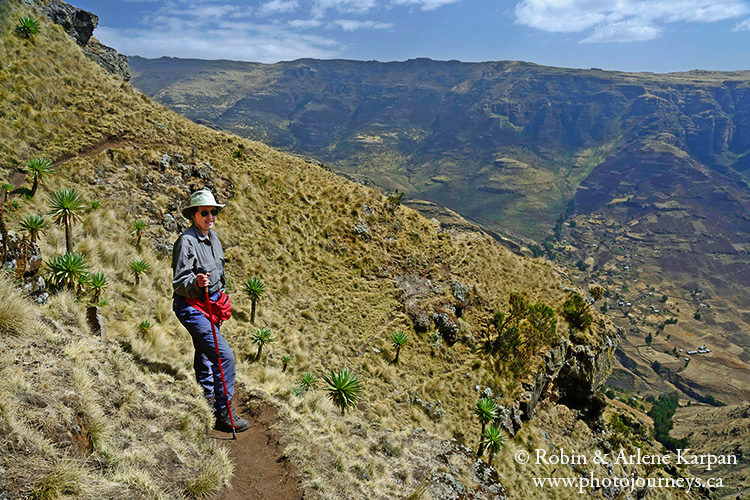
Chenek is also a tiny village where men working for the national park live with their families. Jemale points out his house, and not long after we arrive, his two young kids come running to greet him. Since he lives just up the hill from the campsite, we assume that he’ll be sleeping there during our two-night stay at Chenek. But no, he insists that it’s his job to stay and guard our tent. He sleeps on an old concrete bench outside, his trusty Kalashnikov at his side.
Bwahit Bound
Since we have an extra day at Chenek, we plan on hiking toward Mount Bwahit, its summit reaching over 4,400 metres. Every day as we set out on our hike, we can’t imagine that the impressive scenery could get any better, but it does. Stopping for another well-deserved rest, we overlook a cliff face with an opening to a cave on one side.
“I’d like to see what’s in that cave,” says Getachew as he gets up.
We see no clear route to the opening that drops into a deep nasty canyon, but there’s no stopping him. Getachew has been meticulously careful when guiding us, and never put us in dangerous situations, but on his own he becomes a daredevil, totally unafraid of heights, and oblivious to dangerous precipices. We watch him nimbly climb like a mountain goat over places that make us wince.

Even easy-going Jemale, never fazed by anything, yells a warning in Amharic, but to no avail. Getachew makes it safely to the cave and back, with the help of some fancy rock-climbing acrobatics.
“He belongs in the crazy hospital in Addis!” says Jemale, shaking his head in resignation.
As we climb to over 4,200 metres, we’re really feeling the lack of oxygen, and have to rest more often. We look down on the winding road where a three-ton truck slowly crawls up the hill, the box on the back packed with people. Barely moving, it finally stops. All the passengers climb out and start walking up the steep road. Starved for oxygen, the truck doesn’t have enough power to make the hill. Then it stalls. Each time the driver tries to start it, a deafening backfire echoes through the hills, followed by a billowing cloud of blue smoke. After several tries, the engine finally kicks in, and the truck continues its snail’s-pace climb, eventually catching up to its passengers.
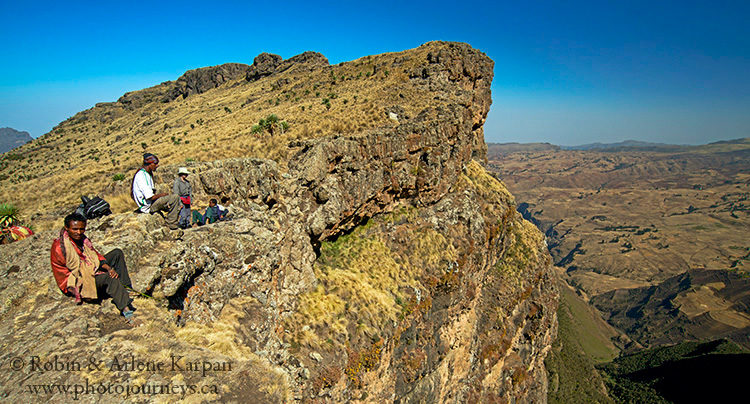
One of our goals is to find rare Walia ibex which sometimes graze in this area. Endemic to the Simien Mountains, these regal-looking, goat-like animals are highly endangered, with only about 500 animals left. We scour the valleys for a few hours, but never spot an ibex. Later that afternoon in the campground, other hikers tell us that they saw ibex nearby. Hopeful that we might see them, we make our way to the bluffs where they were last spotted, then suddenly catch sight of two magnificent males grazing calmly less than 50 metres away. They eventually move into a clearing and cooperate long enough for photos. Even more impressive close-up, they sport long goatee beards and lethal-looking curved horns used to battle each other for dominance.
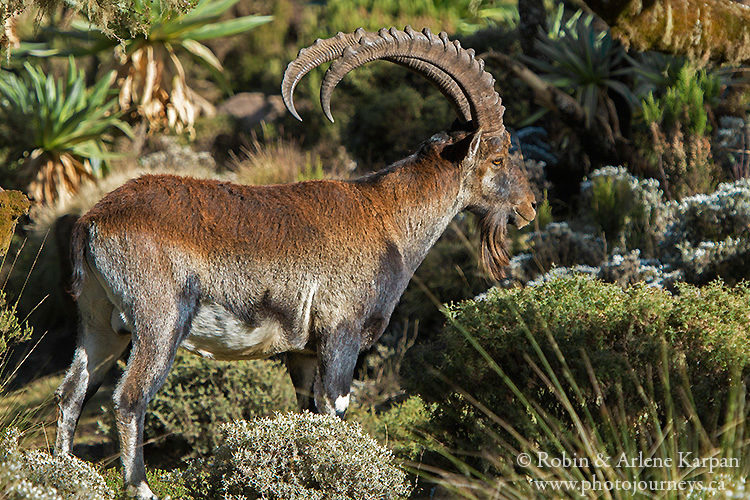
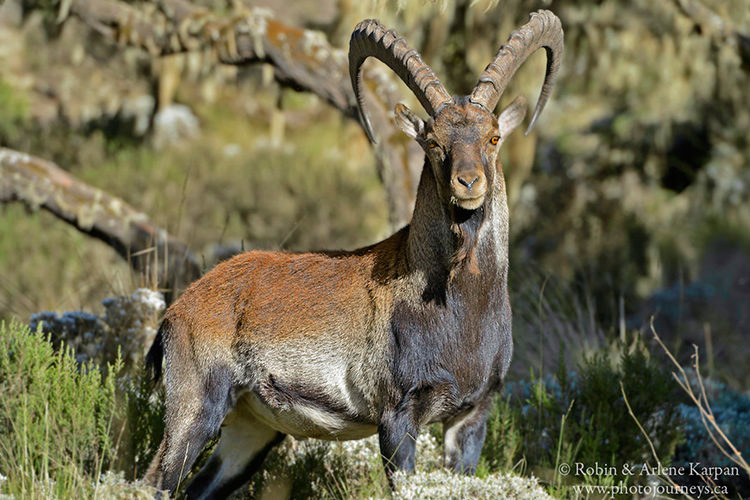
Coffee Break
Before the van picks us up next morning, Jemale invites us to his house for coffee. Drinking coffee is one of the joys of travelling in Ethiopia. Everywhere we go – fancy city restaurants, simple small town cafes, Estefen’s hearty breakfasts at our mountain-top campsites – the coffee is always great. Perhaps not surprising considering that Ethiopia is where the stuff originated. According to legend, a goat herder in the Ethiopian highlands discovered coffee centuries ago when he noticed that his animals became more spirited after eating berries from a particular tree.

Even in Jamale’s modest house, coffee is taken seriously. His wife goes through the whole traditional coffee ceremony, starting with raw beans that she washes in warm water, then roasts in a shallow frying pan over a charcoal fire; an important part of the ceremony is appreciating the aroma of the roasting beans. She pounds the beans using a mortar and pestle then puts the powder in the coffee pot with hot water to brew. It doesn’t get any fresher than this. Jemale’s neighbours wander in and out to share in the coffee and conversation. Coffee isn’t simply a drink in Ethiopia; it’s an integral part of the culture.
It was a fitting way to end a remarkable journey filled with breathtaking landscapes, extraordinary wildlife, fascinating cultures, and enjoyable travel companions – all served up with the world’s best coffee.
Read more about enjoying the freshest coffee anywhere in this post on Photojourneys, describing coffee culture in Ethiopia and in Colombia.
Feel Free to PIN this article
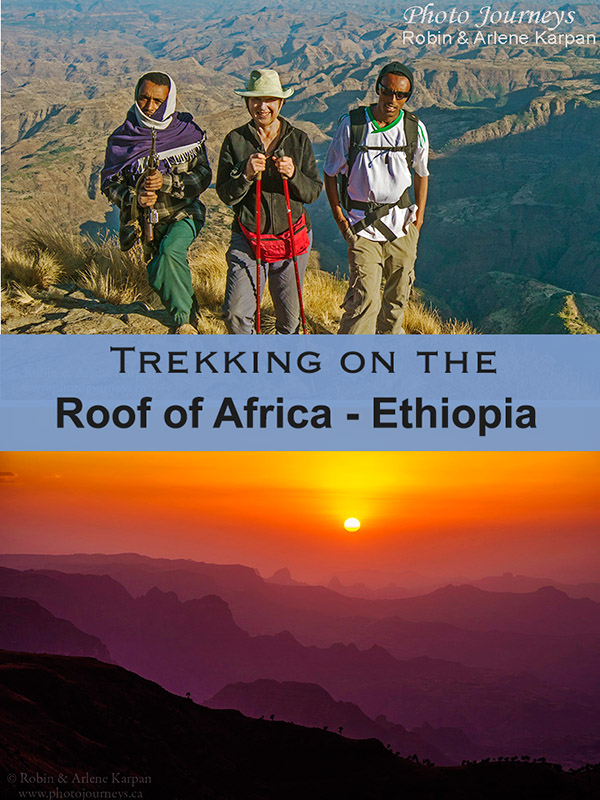


Wow! Absolutely incredible. Your pictures and narrative are amazing! Loved seeing and reading about your adventure. Be safe. Be well. Xxx
Thanks, Irene. We’re pleased to hear that you enjoyed the article.
What a wonderful adventure. Stunning pictures and marvelous scenery to go along with your article!
Thanks Marg. Glad you enjoyed it. So good to hear from you again.
A wonderful read. Happy to come across your photo journey through your Facebook post celebrating coffee. I particularly enjoyed the section about the traditional coffee ceremony because our next door neighbors who are originally from Ethiopia have had this ceremony in their home every time we’ve been invited over–Christmas, Christening, and birthday. Delicious coffee!
I’m not a traveler but as an avid reader I enjoyed your adventure.
Connie – Thank you so much for your comments. We’re pleased to hear that you enjoyed the article. You are fortunate to be invited to the ceremony and now know more about the traditions behind it.